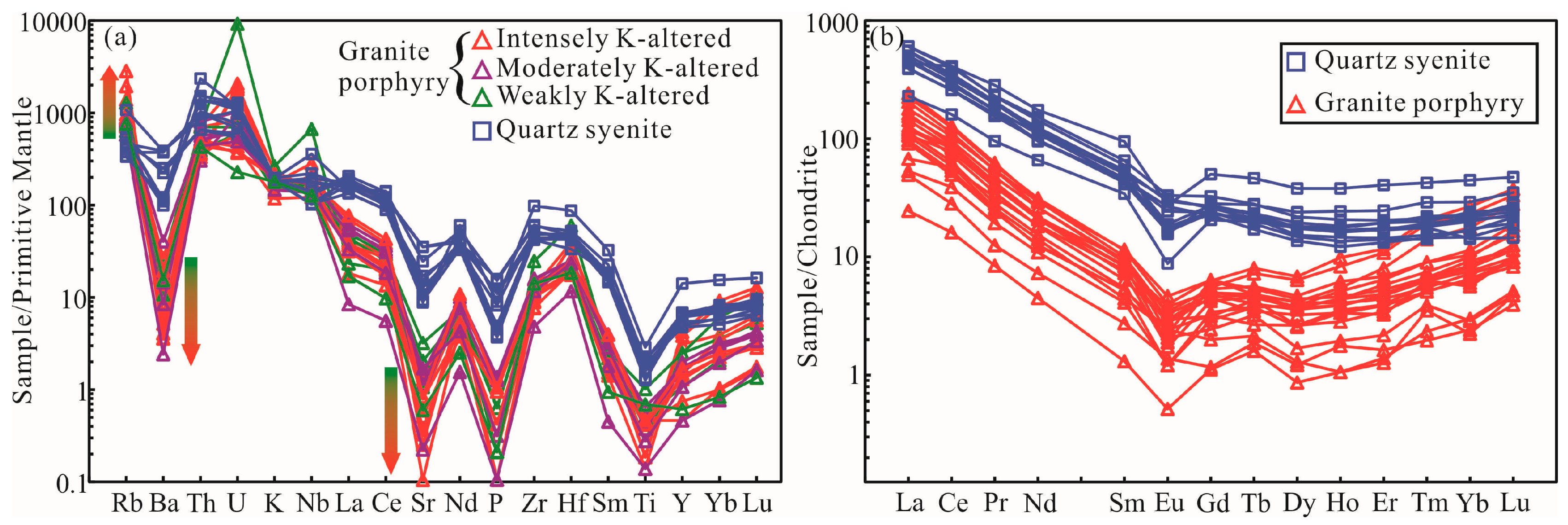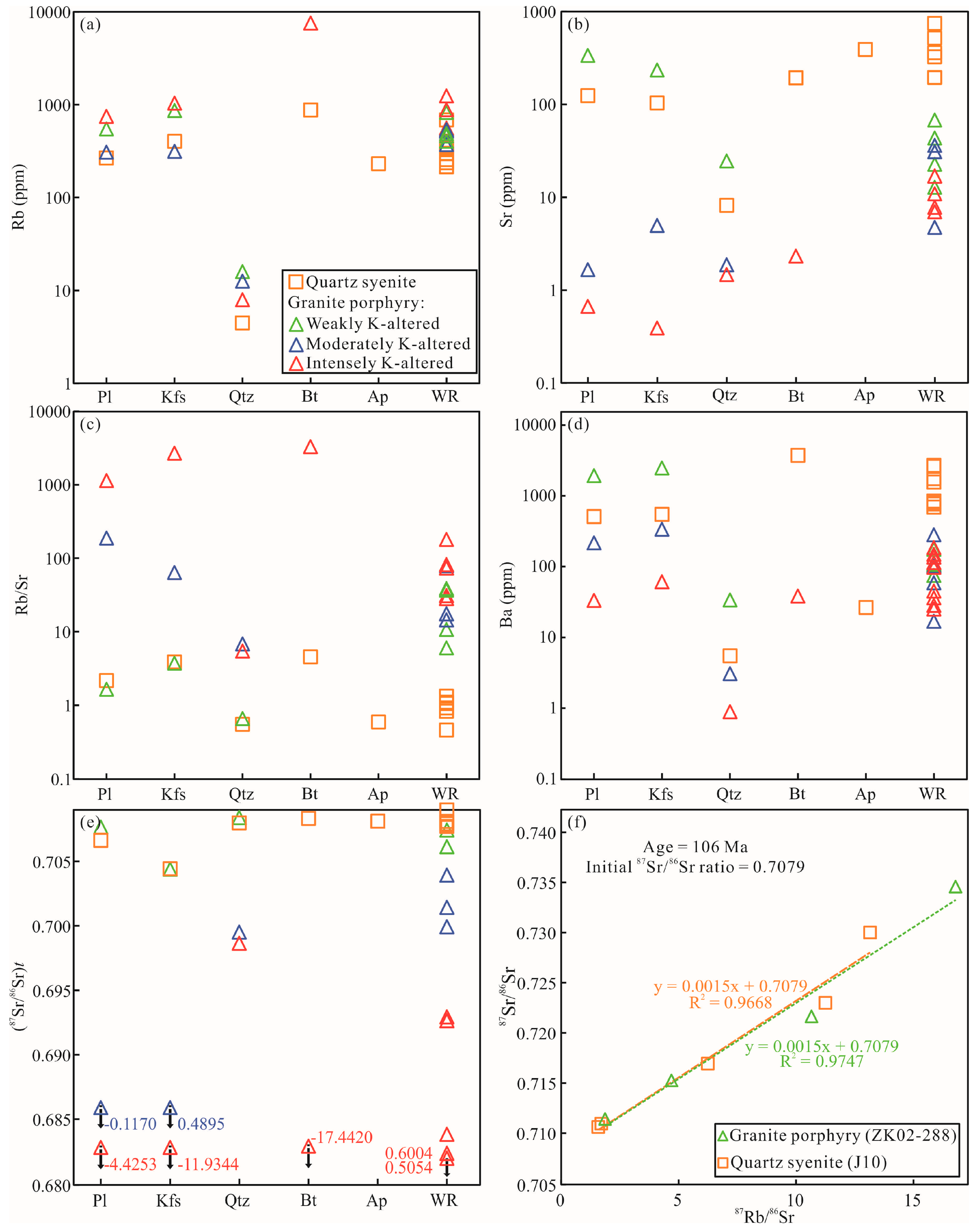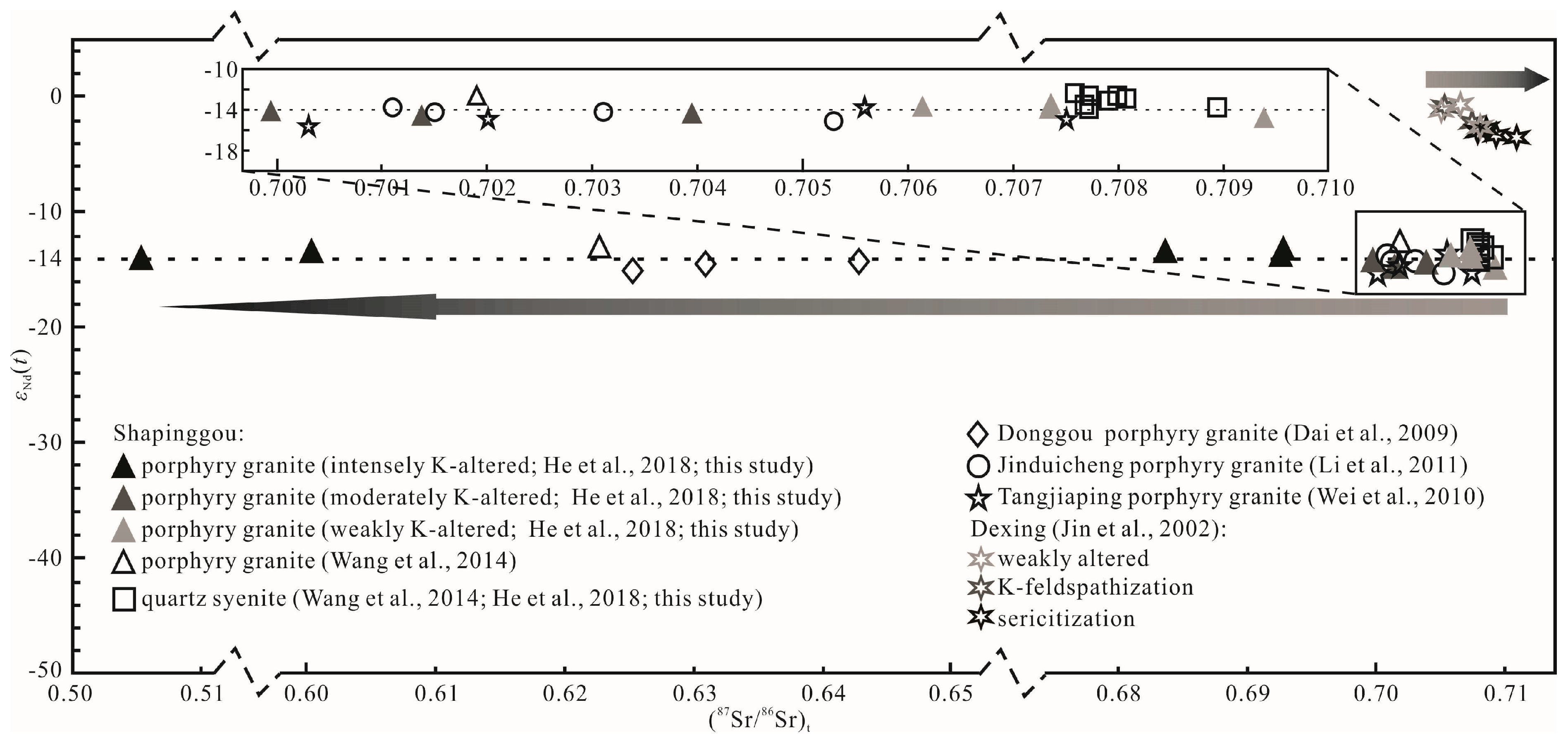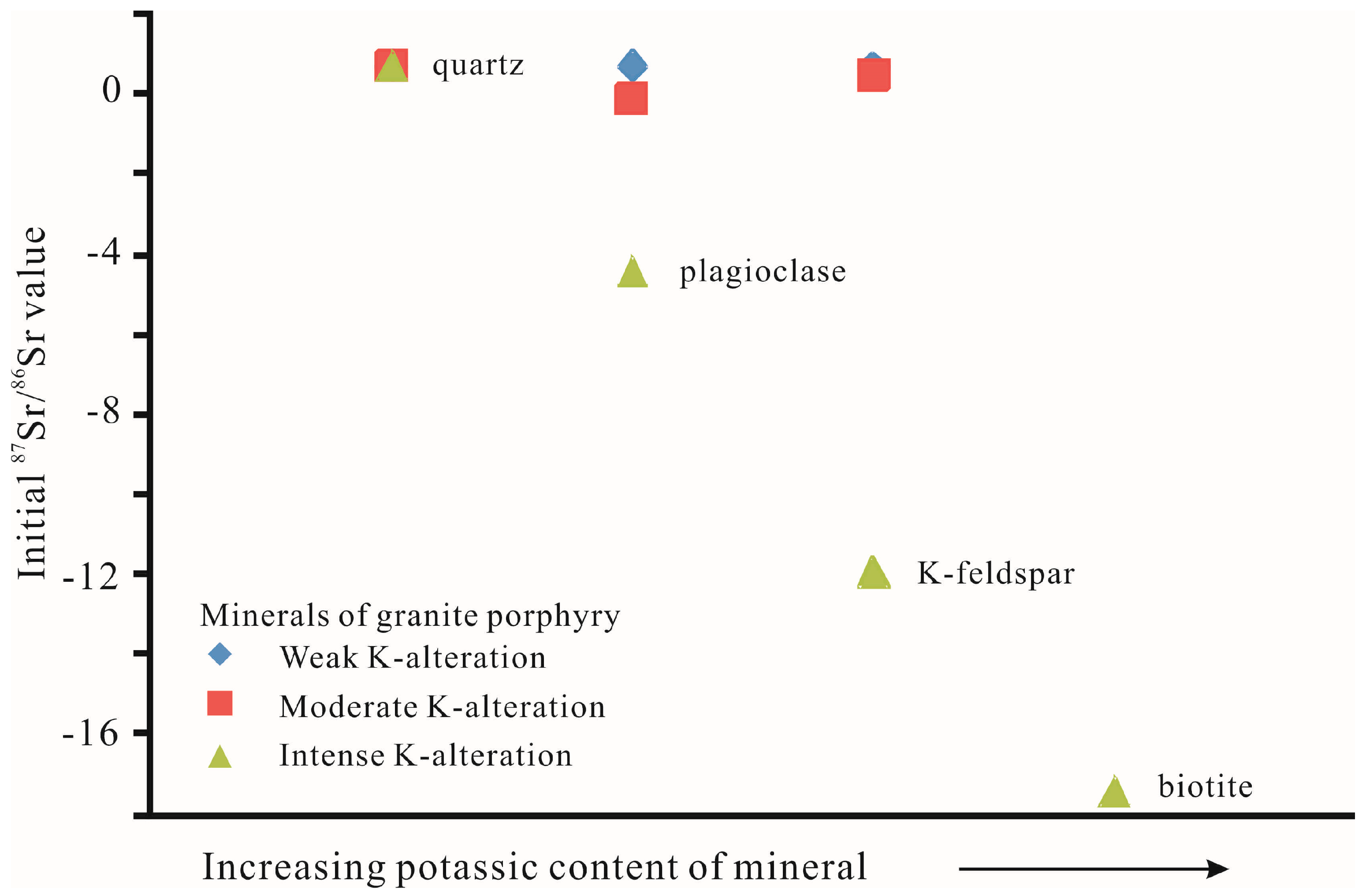Decoupling of Sr-Nd Isotopic Composition Induced by Potassic Alteration in the Shapinggou Porphyry Mo Deposit of the Qinling–Dabie Orogenic Belt, China
Abstract
:1. Introduction
2. Geological Setting and the Shapinggou Porphyry Mo Deposit
3. Geochemistry and Sr-Nd Isotopic Compositions
3.1. Samples and Analytical Methods
3.2. Major and Trace Elemental Geochemistry
3.3. Sr-Nd Isotopic Composition
4. Discussion
4.1. Cause for Anomalously Low Initial 87Sr/86Sr Values
4.2. Consequences of K-Alteration for Porphyry Mo and Cu Deposits
5. Conclusions
Supplementary Materials
Author Contributions
Funding
Acknowledgments
Conflicts of Interest
References
- Zeng, L.S.; Saleeby, J.B.; Ducea, M. Geochemical characteristics of crustal anatexis during the formation of migmatite at the Southern Sierra Nevada, California. Contrib. Mineral. Petrol. 2005, 150, 386–402. [Google Scholar] [CrossRef]
- Zeng, L.S.; Asimow, P.D.; Saleeby, J.B. Coupling of anatectic reactions and dissolution of accessory phases and the Sr and Nd isotope systematics of anatectic melts from a metasedimentary source. Geochim. Cosmochim. Acta 2005, 69, 3671–3682. [Google Scholar] [CrossRef]
- He, J.; Xu, X.C.; Wang, P.; Fan, Z.L.; Fu, Z.Y.; Wang, B.H.; Zhuang, H.D.; Xie, Q.Q. Potassic metasomatism of ore-bearing igneous rocks and response from trace elements and Sr-Nd isotopes in Shapinggou porphyry Mo deposit, Anhui Province. Miner. Depos. 2018, 37, 611–629. [Google Scholar]
- Dai, B.Z.; Jiang, S.Y.; Wang, X.L. Petrogenesis of the granitic porphyry related to the giant molybdenum deposit in Donggou, Henan province, China: Constraints from petrogeochemistry, zircon U-Pb chronology and Sr-Nd-Hf isotopes. Acta Petrol. Sin. 2009, 25, 2889–2901. [Google Scholar]
- Wei, Q.G.; Gao, X.Y.; Zhao, T.P.; Chen, W.; Yang, Y.H. Petrogenesis of Tangjiaping granite porphyry in northern Dabie:Evidence from Zircon LA-ICPMS U-Pb dating and geochemical characteristics. Acta Petrol. Sin. 2010, 26, 1550–1562. [Google Scholar]
- Li, H.Y.; Mao, J.W.; Wang, X.X.; Ye, H.S.; Yang, L. Sr, Nd, Pb isotopic characteristics of granite in Jinduicheng area and their geological significance. Geol. China 2011, 38, 1536–1550. [Google Scholar]
- Wang, G.G.; Ni, P.; Yu, W.; Chen, H.; Jiang, L.L.; Wang, B.H.; Zhang, H.D.; Li, P.F. Petrogenesis of Early Cretaceous post-collisional granitoids at Shapinggou, Dabie Orogen: Implications for crustal architecture and porphyry Mo mineralization. Lithos 2014, 184–187, 393–415. [Google Scholar] [CrossRef]
- Faure, G. Principles of Isotope Geology, 2nd ed.; John Wiley and Sons: Chichester, UK, 1986. [Google Scholar]
- Xie, G.; Mao, J.; Wang, R.; Meng, D.; Sun, J.; Dai, J.; Ren, T.; Li, J.; Zhao, H. Origin of the Lengshuigou porphyry–skarn Cu deposit in the Zha-Shan district, South Qinling, central China, and implications for differences between porphyry Cu and Mo deposits. Miner. Depos. 2017, 52, 621–639. [Google Scholar] [CrossRef]
- Zhou, Q.; Jiang, Y.H.; Zhao, P.; Liao, S.Y.; Jin, G.D. Origin of the Dexing Cu-bearing porphyries, SE China: Elemental and Sr-Nd-Pb-Hf isotopic constraints. Int. Geol. Rev. 2012, 54, 572–592. [Google Scholar] [CrossRef]
- Qin, K.Z.; Xia, D.X.; Li, G.M.; Xiao, B.; Duo, J.; Jiang, G.W.; Zhao, J.X. Qulong Porphyry-Skarn Cu-Mo Deposit, Tibet; Science Press: Beijing, China, 2014. (In Chinese) [Google Scholar]
- Pirajno, F.; Zhou, T.F. Intracontinental Porphyry and Porphyry-Skarn Mineral Systems in Eastern China: Scrutiny of a Special Case “Made-in-China”. Econ. Geol. 2015, 110, 603–629. [Google Scholar] [CrossRef]
- Chen, Y.J.; Wang, P.; Li, N.; Yang, Y.F.; Pirajno, F. The collision-type porphyry Mo deposits in Dabie Shan, China. Ore Geol. Rev. 2017, 81, 405–430. [Google Scholar] [CrossRef]
- Li, N.; Pirajno, F. Early Mesozoic Mo mineralization in the Qinling Orogen: An overview. Ore Geol. Rev. 2017, 81, 431–450. [Google Scholar] [CrossRef]
- Hu, S.X.; Zhou, Y.S.; Sun, M.Z. The genesis relationship of K-metasomatism and Mo deposit. J. Nanjing Univ. 1963, 14, 99–117. (In Chinese) [Google Scholar]
- Hu, S.X. The Geology and Mineralization in the Suture Zone between North China Craton and South China Craton; Nanjing University Press: Nanjing, China, 1988. (In Chinese) [Google Scholar]
- Du, L.T. Geochemical principle of K-metasomatism. Sci. China Chem. 1986, 16, 81–90. (In Chinese) [Google Scholar]
- Du, L.T. The important significance of alkali-metasomatic rock studies. Miner. Depos. 2002, 21, 953–958. [Google Scholar]
- Fitton, J.G.; Upton, B.G.J. Alkaline Igneous Rocks; Blackwell Scientific Publication: New York, NY, USA, 1987. [Google Scholar]
- Zhang, Z.W.; Zhu, B.Q.; Chang, X.Y.; Xie, J. Major element characteristics of the alkali-rich intrusive rocks zone and distribution of the subzones in the north ern part of east Qinling, China. Acta Petrol. Sin. 2002, 18, 468–474. [Google Scholar]
- Zhao, Z.H.; Xiong, X.L.; Wang, Q.; Bao, Z.W.; Zhang, Y.-Q.; Xie, Y.-W.; Ren, S.-K. Alkaline rich igneous rock and giant-super giant Au-Cu deposit. Sci. China Earth Sci. 2002, 32, 1–10. (In Chinese) [Google Scholar]
- Du, L.T.; Wang, W.G. Alkaline mantle fluids and alkali-rich hydrothermal metallogenesis. Miner. Depos. 2009, 28, 599–610. [Google Scholar]
- Xie, R.J.; Peng, S.L. K2O content, K-metasomatism of rock and metallogenesis. Geotecton. Metallog. 1998, 22, 274–279. [Google Scholar]
- Li, C.Y.; Wang, F.Y.; Hao, X.L.; Ding, X.; Zhang, H.; Ling, M.X.; Zhou, J.B.; Li, Y.L.; Fan, W.M.; Sun, W.D. Formation of the world’s largest molybdenum metallogenic belt: A plate-tectonic perspective on the Qinling molybdenum deposits. Int. Geol. Rev. 2012, 54, 1093–1112. [Google Scholar] [CrossRef]
- Ni, P.; Wang, G.G.; Yu, W.; Chen, H.; Jiang, L.L.; Wang, B.H.; Zhang, H.D.; Xu, Y.F. Evidence of fluid inclusions for two stages of fluid boiling in the formation of the giant Shapinggou porphyry Mo deposit, Dabie Orogen, Central China. Ore Geol. Rev. 2015, 65, 1078–1094. [Google Scholar] [CrossRef]
- Stein, H. Highly precise and accurate Re-Os ages for molybdenite from the East Qinling molybdenum belt, Shaanxi Province, China. Econ. Geol. 1997, 92, 827–835. [Google Scholar] [CrossRef]
- Mao, J.W.; Pirajno, F.; Xiang, J.F.; Gao, J.J.; Ye, H.S.; Li, Y.F.; Guo, B.J. Mesozoic molybdenum deposits in the east Qinling–Dabie orogenic belt: Characteristics and tectonic settings. Ore Geol. Rev. 2011, 43, 264–293. [Google Scholar] [CrossRef]
- Chen, W.; Xu, Z.; Lu, X.; Yang, X.; Li, H.; Qu, W.; Chen, J.; Wang, H.; Wang, S. Petrogenesis of the Bao’anzhai granite and associated Mo mineralization, western Dabie orogen, east-central China: Constraints from zircon U-Pb and molybdenite Re-Os dating, whole-rock geochemistry, and Sr-Nd-Pb-Hf isotopes. Int. Geol. Rev. 2013, 55, 1220–1238. [Google Scholar] [CrossRef]
- Gao, Y.; Mao, J.; Ye, H.; Meng, F.; Li, Y. A review of the geological characteristics and geodynamic setting of the late Early Cretaceous molybdenum deposits in the East Qinling–Dabie molybdenum belt, East China. J. Asian Earth Sci. 2015, 108, 81–96. [Google Scholar] [CrossRef]
- Mi, M.; Li, C.Y.; Sun, W.D. Qian’echong low-F porphyry Mo deposits in the Dabie Mountains, central China. Lithos 2015, 239, 157–169. [Google Scholar] [CrossRef]
- Wang, P.; Wang, Y.; Yang, Y.F. Zircon U-Pb geochronology and isotopic geochemistry of the Tangjiaping Mo deposit, Dabie Shan, eastern China: Implications for ore genesis and tectonic setting. Ore Geol. Rev. 2017, 81, 466–483. [Google Scholar] [CrossRef]
- Zhang, J.; Ye, H.S.; Zhou, K.; Meng, F. Processes of ore genesis at the world-class Yuchiling molybdenum deposit, Henan province, China. J. Asian Earth Sci. 2014, 79, 666–681. [Google Scholar] [CrossRef]
- Li, N.; Ulrich, T.; Chen, Y.J.; Thomsen, T.B.; Pease, V.; Pirajno, F. Fluid evolution of the Yuchiling porphyry Mo deposit, East Qinling, China. Ore Geol. Rev. 2012, 48, 442–459. [Google Scholar] [CrossRef]
- Yang, Y.F.; Wang, P.; Chen, Y.J.; Li, Y. Geochronology and geochemistry of the Tianmugou Mo deposit, Dabie Shan, eastern China: Implications for ore genesis and tectonic setting. Ore Geol. Rev. 2017, 81, 484–503. [Google Scholar] [CrossRef]
- Zhang, H.D.; Wang, B.H.; Hao, Y.J.; Cheng, S.; Xiang, B. Geological characteristics and comprehensive ore-prospecting information of Shapinggou porphyry-type molybdenum deposit in Anhui Province. Miner. Depos. 2012, 31, 41–51. [Google Scholar]
- Xu, X.C.; Lou, J.W.; Xie, Q.Q.; Xiao, Q.; Liang, J.; Lu, S.M. Geochronology and tectonic setting of Pb-Zn-Mo deposits and related igneous rocks in the Yinshan region, Jinzhai, Anhui province, China. Ore Geol. Rev. 2011, 43, 132–141. [Google Scholar] [CrossRef]
- Huang, F.; Wang, D.H.; Lu, S.M.; Chen, Y.C.; Wang, B.H.; Li, C. Molybdenite Re-Os isotopic age of Shapinggou Mo deposit in Anhui Province and Mesozoic Mo ore-forming stages in East Qinling–Dabie Mountain region. Miner. Depos. 2011, 30, 1039–1057. [Google Scholar]
- Chen, H.J.; Chen, Y.J.; Zhang, J.; Chen, X.Z.; Zhang, H.D. Zircon U-Pb ages and Hf isotope characteristics of the ore-bearing intrusion from the Shapinggou molybdenum deposit, Jinzhai County, Anhui Province. Acta Petrol. Sin. 2013, 29, 131–145. [Google Scholar]
- Ren, Z.; Zhou, T.; Hollings, P.; White, N.C. Magmatism in the Shapinggou district of the Dabie orogen, China: Implications for the formation of porphyry Mo deposits in a collisional orogenic belt. Lithos 2018, 308–309, 346–363. [Google Scholar] [CrossRef]
- Zhang, H.; Li, C.Y.; Yang, X.Y.; Sun, Y.L.; Deng, J.H.; Liang, H.Y.; Wang, R.L.; Wang, B.H.; Wang, Y.X.; Sun, W.D. Shapinggou: The largest climax-type porphyry mo deposit in China. Int. Geol. Rev. 2014, 56, 313–331. [Google Scholar] [CrossRef]
- He, T.; Yang, X.; Deng, J.; Zhang, H.; Zha, S.; Li, C.; Zhang, H. Geochronology, geochemistry and Hf–Sr–Nd isotopes of the ore-bearing syenite from the Shapinggou porphyry Mo deposit, East Qinling–Dabie orogenic belt. Solid Earth Sci. 2016, 1, 101–117. [Google Scholar] [CrossRef]
- Lu, H.Z.; Bi, X.W.; Wang, D.; Shan, Q. Ore-forming fluids of porphyry copper (molybdenum-gold) deposits. Miner. Depos. 2016, 35, 933–952. [Google Scholar] [CrossRef]
- He, J.; Xu, X.C.; Xie, Q.Q.; Fan, Z.L.; Chen, T.H. Evidence from pseudomorphous β-quartz phenocryst for decompression of rock-forming and ore-forming processes in Shapinggou porphyry Mo deposit. Sci. China Earth Sci. 2016, 59, 1014–1024. [Google Scholar] [CrossRef]
- Xu, Z.Q.; Li, Y.; Liang, F.H.; Pei, X.Z. A Connection between of the Paleo-Tethys Suture Zone in the Qinling–Dabie-Sulu Orogenic Belt. Acta Geol. Sin. 2015, 89, 671–680. [Google Scholar]
- Wang, Y.S.; Jiang, L.L.; Zhu, G.; Song, C.Z. Formation of present tectonic framework in Dabie Mountains: Evidences from quartz C-axis fabrics. Acta Petrol. Sin. 2009, 25, 219–231. [Google Scholar]
- Mao, J.W.; Xie, G.Q.; Bierlein, F.; Qü, W.J.; Du, A.D.; Ye, H.S.; Pirajno, F.; Li, H.M.; Guo, B.J.; Li, Y.F.; et al. Tectonic implications from Re-Os dating of Mesozoic molybdenum deposits in the East Qinling–Dabie orogenic belt. Geochim. Cosmochim. Acta 2008, 72, 4607–4626. [Google Scholar] [CrossRef]
- Hou, Z.H.; Wang, C.X. Determination of 35 trace elements in geological samples by inductively coupled plasma mass spectrometry. J. Univ. Sci. Technol. China 2007, 37, 940–944. [Google Scholar]
- Chen, F.; Li, X.H.; Wang, X.L.; Li, Q.L.; Siebel, W. Zircon age and Nd-Hf isotopic composition of the Yunnan Tethyan belt, southwestern China. Int. J. Earth Sci. 2007, 96, 1179–1194. [Google Scholar] [CrossRef]
- Yang, L.; Chen, F.; Liu, B.X.; Hu, Z.P.; Qi, Y.; Wu, J.D.; He, J.F.; Siebel, W. Geochemistry and Sr-Nd-Pb-Hf isotopic composition of the Donggou Mo-bearing granite porphyry, Qinling orogenic belt, central China. Int. Geol. Rev. 2013, 55, 1261–1279. [Google Scholar] [CrossRef]
- Sun, S.S.; Mcdonough, W.F. Chemical and isotopic systematics of oceanic basalts: Implications for mantle composition and processes. Geol. Soc. Lond. Spec. Publ. 1989, 42, 313–345. [Google Scholar] [CrossRef]
- Zhang, Z.W.; Zhang, Z.S.; Dong, Y.; Peng, W.F.; Zhang, J.J. Molybdenum deposits in eastern qinling, central china: Deep structural constraints on their formation. Acta Mineral. Sin. 2007, 27, 372–378. [Google Scholar]
- Guo, B.; Zhu, L.M.; Li, B.; Xu, J.; Wang, J.Q.; Gong, H.J. Isotopic and element geochemical study of Jinduicheng superlarge porphyry Mo deposit in East Qinling area. Miner. Depos. 2009, 28, 265–281. [Google Scholar]
- Jin, Z.D.; Zhu, J.C.; Li, F.C. O, Sr and Nd Isotopic Tracing of Ore-forming Process in Dexing Porphyry Copper Deposit, Jiangxi Province. Miner. Depos. 2002, 21, 341–349. [Google Scholar]
- Wang, Y.R.; Hu, S.X. The experiment study on Au activation and transfer: The example from Au deposit on North China Craton. Sci. China Earth Sci. 2000, 30, 499–508. (In Chinese) [Google Scholar]
- Cheng, P.; Koyanagi, G.K.; Bohme, D.K. On the chemical resolution of the 87Rb+(s0)/87Sr+(s1) isobaric interference: A kinetic search for an optimum reagent. Anal. Chim. Acta 2008, 627, 148–153. [Google Scholar] [CrossRef]
- Bolea-Fernandez, E.; Van Malderen, S.J.M.; Balcaen, L.; Resano, M.; Vanhaecke, F. Laser ablation-tandem ICP-mass spectrometry (LA-ICP- MS/MS) for direct Sr isotopic analysis of solid samples with high Rb/Sr ratios. J. Anal. At. Spectrom. 2016, 31, 464–472. [Google Scholar] [CrossRef]
- Zhu, X.Y.; Chen, F.; Liu, B.X.; Siebel, W. Zircon U-Pb and K-feldspar megacryst Rb-Sr isotopic ages and Sr-Hf isotopic composition of the Mesozoic Heyu pluton, eastern Qingling orogen, China. Lithos 2013, 156–159, 31–40. [Google Scholar] [CrossRef]
- Giletti, B.J.; Casserly, J.E.D. Strontium diffusion kinetics in plagioclase feldspars. Geochim. Cosmochim. Acta 1994, 58, 3785–3793. [Google Scholar] [CrossRef]
- Allègre, C.J.; Othman, D. Ben Nd-Sr isotopic relationship in granitoid rocks and continental crust development: A chemical approach to orogenesis. Nature 1980, 335–342. [Google Scholar] [CrossRef]
- Solomon, G.C.; Taylor, H.P., Jr. Isotopic evidence for the origin of Mesozoic and Cenozoic granitic plutons in the northern Great Basin. Geology 1989, 17, 591–594. [Google Scholar] [CrossRef]
- Chen, S.Q. Experimental geochemical study on Cu and Mo. Earth Environ. 1990, 4, 62–63. (In Chinese) [Google Scholar]
- Hu, S.X.; Ye, Y.; Fang, C.Q. Petrology of the Metasomatically Altered Rocks and Its Significance in Prospecting; Geological Publishing House: Beijing, China, 2004. (In Chinese) [Google Scholar]
- Richards, J.P. Postsubduction porphyry Cu-Au and epithermal Au deposits: Products of remelting of subduction-modified lithosphere. Geology 2009, 37, 247–250. [Google Scholar] [CrossRef]
- Cooke, D.R.; Hollings, P. Giant Porphyry Deposits: Characteristics, Distribution, and Tectonic Controls. Econ. Geol. 2005, 100, 801–818. [Google Scholar] [CrossRef]
- Audétat, A. Compositional evolution and formation conditions of magmas and fluids related to porphyry mo mineralization at Climax, Colorado. J. Petrol. 2014, 56, 1519–1546. [Google Scholar] [CrossRef] [Green Version]
- Sun, W.D.; Huang, R.F.; Li, H.; Hu, Y.B.; Zhang, C.C.; Sun, S.J.; Zhang, L.P.; Ding, X.; Li, C.Y.; Zartman, R.E. Porphyry deposits and oxidized magmas. Ore Geol. Rev. 2015, 65, 97–131. [Google Scholar] [CrossRef]
- Cox, S.F.; Knackstedt, M.A.; Braun, J. Principles of structural control on permeability and fluid flow in hydrothermal systems. Soc. Econ. Geol. Rev. 2001, 14, 1–24. [Google Scholar]
- Sillitoe, R.H. A Plate Tectonic Model for the Origin of Porphyry Copper Deposits. Econ. Geol. 1972, 67, 184–197. [Google Scholar] [CrossRef]
- Sillitoe, R.H. Porphyry Copper Systems. Econ. Geol. 2010, 105, 3–41. [Google Scholar] [CrossRef] [Green Version]
- Solomon, M. Subduction, arc reversal, and origin of porphyry copper-gold deposits in island arcs. Geology 1990, 18, 630–633. [Google Scholar] [CrossRef]
- Richards, J.P. Tectono-magmatic precursors for porphyry Cu-(Mo-Au) deposit formation. Econ. Geol. 2003, 98, 1515–1533. [Google Scholar] [CrossRef]
- Audétat, A. Source and evolution of molybdenum in the porphyry Mo(-Nb) deposit at Cave Peak, Texas. J. Petrol. 2010, 51, 1739–1760. [Google Scholar] [CrossRef]
- Buret, Y.; von Quadt, A.; Heinrich, C.; Selby, D.; Wälle, M.; Peytcheva, I. From a long-lived upper-crustal magma chamber to rapid porphyry copper-emplacement: Reading the geochemistry of zircon crystals at Bajo de la Alumbrera (NW Argentina). Earth Planet. Sci. Lett. 2016, 450, 120–131. [Google Scholar] [CrossRef] [Green Version]
- Zheng, Y.C.; Liu, S.A.; Wu, C.D.; Griffin, W.L.; Li, Z.Q.; Xu, B.; Yang, Z.M.; Hou, Z.Q.; O’Reilly, S.Y. Cu isotopes reveal initial Cu enrichment in sources of giant porphyry deposits in a collisional setting. Geology 2019, 47, 135–138. [Google Scholar] [CrossRef]
- Sun, W.D.; Ling, M.X.; Yang, X.Y.; Fan, W.M.; Ding, X.; Liang, H.Y. Ridge subduction and porphyry copper-gold mineralization: An overview. Sci. China Earth Sci. 2010, 53, 475–484. [Google Scholar] [CrossRef]
- Sun, W.D.; Liang, H.Y.; Ling, M.X.; Zhan, M.Z.; Ding, X.; Zhang, H.; Yang, X.Y.; Li, Y.L.; Ireland, T.R.; Wei, Q.R.; et al. The link between reduced porphyry copper deposits and oxidized magmas. Geochim. Cosmochim. Acta 2013, 103, 263–275. [Google Scholar] [CrossRef]







Publisher’s Note: MDPI stays neutral with regard to jurisdictional claims in published maps and institutional affiliations. |
© 2021 by the authors. Licensee MDPI, Basel, Switzerland. This article is an open access article distributed under the terms and conditions of the Creative Commons Attribution (CC BY) license (https://creativecommons.org/licenses/by/4.0/).
Share and Cite
He, J.; Xu, X.; Fu, Z.; An, Y.; Chen, T.; Xie, Q.; Chen, F. Decoupling of Sr-Nd Isotopic Composition Induced by Potassic Alteration in the Shapinggou Porphyry Mo Deposit of the Qinling–Dabie Orogenic Belt, China. Minerals 2021, 11, 910. https://doi.org/10.3390/min11080910
He J, Xu X, Fu Z, An Y, Chen T, Xie Q, Chen F. Decoupling of Sr-Nd Isotopic Composition Induced by Potassic Alteration in the Shapinggou Porphyry Mo Deposit of the Qinling–Dabie Orogenic Belt, China. Minerals. 2021; 11(8):910. https://doi.org/10.3390/min11080910
Chicago/Turabian StyleHe, Jun, Xiaochun Xu, Zhongyang Fu, Yuhua An, Tianhu Chen, Qiaoqin Xie, and Fukun Chen. 2021. "Decoupling of Sr-Nd Isotopic Composition Induced by Potassic Alteration in the Shapinggou Porphyry Mo Deposit of the Qinling–Dabie Orogenic Belt, China" Minerals 11, no. 8: 910. https://doi.org/10.3390/min11080910
APA StyleHe, J., Xu, X., Fu, Z., An, Y., Chen, T., Xie, Q., & Chen, F. (2021). Decoupling of Sr-Nd Isotopic Composition Induced by Potassic Alteration in the Shapinggou Porphyry Mo Deposit of the Qinling–Dabie Orogenic Belt, China. Minerals, 11(8), 910. https://doi.org/10.3390/min11080910







